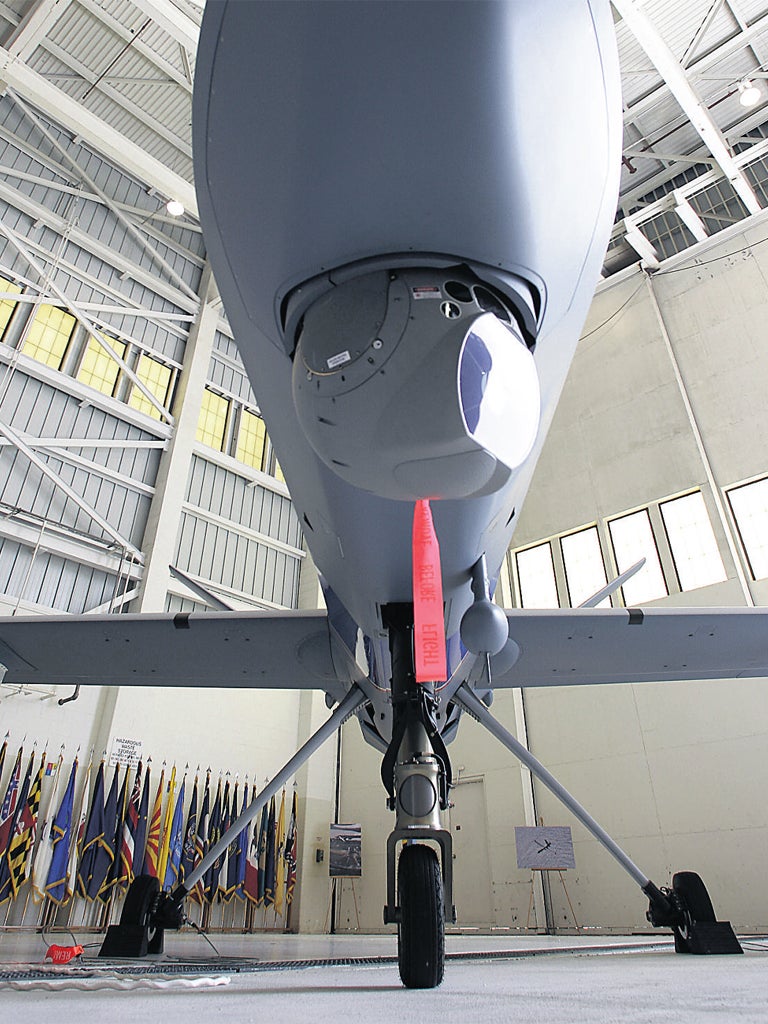Rupert Cornwell: Home on the range, where the spy drones fly
Out of America: Use of aerial surveillance gadget in North Dakota police case could be a sign of things to come


It all started when the Brossart family refused to give back half a dozen cows that one day last summer strayed on to its 3,000-acre spread near Grand Forks, North Dakota. Kelly Janke, the Nelson County sheriff, went to get them back, but was chased off by three of the Brossart children, wielding shotguns. So Mr Janke called in reinforcements: three deputies, a crack Swat team, ambulances, a bomb-disposal squad – and a $10m unmanned Predator drone, of the type the US military uses to hunt down enemy fighters in places like Yemen and Afghanistan.
And over America's vast prairies, the Predator also did the business. From two miles up in the sky it located the three brothers and established they were unarmed, enabling police to move in and arrest them (and presumably retrieve the cows).
Drones have been much in the news lately, what with Iran's claim to have brought down a Sentinel stealth drone operated by the CIA, and the crash of a Reaper drone, deployed to combat piracy off east Africa. But the wandering cows of North Dakota constitute a historical first. Never before, it appears, has a drone been used to make arrests in a purely domestic law enforcement case. And a new chapter in America's eternal debate on privacy has been opened: where should the line be drawn between an individual's right to go about his business unmolested, and the right of the state to intrude on that business in order to protect society?
Military drones, in fact, have been around since the mid-1990s, while the Department of Homeland Security – from whom Sheriff Janke called in the Predator – has been using them for a while now in US border areas to fight illegal immigration, and to help with disaster relief. Even so, when the Los Angeles Times broke news of the Brossart affair, it came as a real shock. It should not have been.
With drones, as with every branch of consumer electronics, the technology grows more powerful and user-friendly every year, while costs fall. Police departments have been itching to get their hands on drones for surveillance operations that would be far more expensive if carried out by humans. For their part, the companies (all of them part of the powerful defence industry lobby) that make the things are only too eager to tap into a lucrative domestic market.
The real worry of the North Dakota case is not that the process has started. Rather, it is that it may herald military-style "mission creep" – only on home soil. First border protection, then help with a criminal case near that border – what's to stop drones being routinely used for every sort of police operation? After all, Sheriff Janke's warrant seems to have made no mention of aerial surveillance. Word that the FAA, the body that runs American civil aviation, is about to bring in new rules allowing unmanned drones to fly more frequently has only increased such anxiety.
Nor is police work likely to be the end of it. Drones are flying video cameras, the difference being they can perform that function more cheaply, and for longer stretches, than any police helicopter. As such they are the paparazzi's best friend. What celeb would ever be safe from invisible but permanent scrutiny a mile aloft?
Indeed, evolving technology makes that more likely. Compared with the industry's latest offerings, the Predator is a lumbering giant. Take the Qube, a drone that weighs just 5lb, with launch equipment you can fit in a car boot. The device, buzzing like a hornet as it flies 200ft above the ground, has been developed specifically for law enforcement by AeroVironment, the California-based company that is the biggest supplier of small drones to the US military.
The one unsolved technical problem is that drones are far more apt to crash than manned aircraft – by one estimate, 25 large drones worldwide have crashed this year alone. But if the FAA is persuaded they are safe, the Qube could soon be coming to state police departments across the land. "This is a tool that many law-enforcement agencies never imagined they could have," an AeroVironment executive proclaims.
And the Qube is not the end of it. Even smaller are so-called "hummingbird" drones that can fly into buildings unobserved and provide a live video feed of what's going on inside: electronic wiretapping, but with pictures as well. Small wonder that the ACLU, the leading US civil liberties group, demanded in a report last week that "hummingbirds" be subject to the same regulation as police wiretaps.
And if unarmed drones replace human surveillance, then why not armed drones instead of armed human police? This is but a distant nightmare. But just in case, AeroVironment can offer the Switchblade, a so-called "kamikaze" drone that fits inside a backpack. Like a switchblade knife, the wings of the device pop out when it is removed from its case. The company describes its product as a portable, single-use "loitering munition". The Switchblade hunts down and destroys its target, destroying itself in the process. Who needs police sharpshooters?
But a drone-infested future need not be Orwellian. The advantages, in terms of disaster assessment and missing person searches are obvious. And it might actually lead to more effective privacy laws. Despite technology's giant strides over the past quarter of a century, the use of electronic surveillance is still governed by a 1986 statute. If the cows of North Dakota produce an overhaul of that regulation, they will not have strayed in vain.
Join our commenting forum
Join thought-provoking conversations, follow other Independent readers and see their replies
Comments